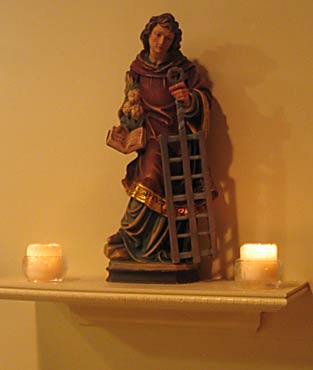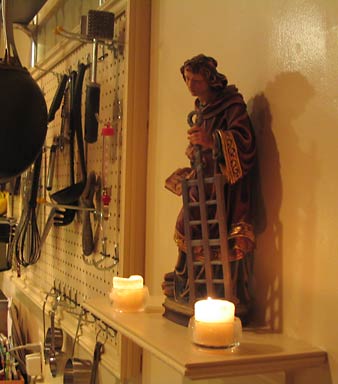We've been waiting for this. On December 22, Pope Benedict spoke to the Roman Curia with a look back at the year, but it has taken a couple of weeks before the Vatican released an official translation of his message. There's even been a certain amount of fuss in the Italian press about the delay; Sandro Magister asked if somebody at the Vatican was trying to keep the speech from getting attention. But no fear: we bloggers will comb through it all.
The Pope looks back to the last days of Pope John Paul, in light of the late pontiff's teaching about the role of Jesus' suffering in the redemption of the world.
From the theme of the World Youth Day ("we have come to worship Him"), he looks to the resurgence of Eucharistic adoration, and the Synod on the Eucharist.
But the most extensive part of his address is a look at the Second Vatican Council, at its 40th anniversary:
What has been the result of the Council? Was it well received? What, in the acceptance of the Council, was good and what was inadequate or mistaken? What still remains to be done? No one can deny that in vast areas of the Church the implementation of the Council has been somewhat difficult, even without wishing to apply to what occurred in these years the description that St. Basil, the great Doctor of the Church, made of the Church's situation after the Council of Nicaea: He compares her situation to a naval battle in the darkness of the storm, saying among other things: "The raucous shouting of those who through disagreement rise up against one another, the incomprehensible chatter, the confused din of uninterrupted clamoring, has now filled almost the whole of the Church, falsifying through excess or failure the right doctrine of the faith ..."
In the Council, the Church responded to a modernity that had progressively denied God and attempted to marginalize religion from social life into a purely personal sphere. As St. Thomas Aquinas redeemed classical philosophy by reconciling it with Christian faith, the Second Vatican Council sought to open a new dialogue with modern societies by showing one of their fundamental principles -- the religious liberty of man in society -- can be harmonized with the Catholic faith.
The part of the address I value most is the Pope's discussion on how the Council should be interpreted: not as a "discontinuity", a revolutionary event replacing all that had gone before it; but rather as a "reform" by the Church, which strives and seeks always to turn afresh toward the Lord, in continuity with what has gone before. Here the Pope describes the result of misunderstanding the council:
The hermeneutic of discontinuity risks ending in a split between the pre-conciliar Church and the post-conciliar Church. It asserts that the texts of the Council as such do not yet express the true spirit of the Council. It claims that they are the result of compromises in which, to reach unanimity, it was found necessary to keep and reconfirm many old things that are now pointless. However, the true spirit of the Council is not to be found in these compromises but instead in the impulses toward the new that are contained in the texts.
These innovations alone were supposed to represent the true spirit of the Council, and starting from and in conformity with them, it would be possible to move ahead. Precisely because the texts would only imperfectly reflect the true spirit of the Council and its newness, it would be necessary to go courageously beyond the texts and make room for the newness in which the Council's deepest intention would be expressed, even if it were still vague.
In a word: It would be necessary not to follow the texts of the Council but its spirit. In this way, obviously, a vast margin was left open for the question on how this spirit should subsequently be defined and room was consequently made for every whim.
The nature of a Council as such is therefore basically misunderstood. In this way, it is considered as a sort of constituent that eliminates an old constitution and creates a new one.
In contrast:
The hermeneutic of discontinuity is countered by the hermeneutic of reform [...]
Here I shall cite only John XXIII's well-known words, which unequivocally express this hermeneutic when he says that the Council wishes "to transmit the doctrine, pure and integral, without any attenuation or distortion." And he continues: "Our duty is not only to guard this precious treasure, as if we were concerned only with antiquity, but to dedicate ourselves with an earnest will and without fear to that work which our era demands of us …." It is necessary that "adherence to all the teaching of the Church in its entirety and preciseness ..." be presented in "faithful and perfect conformity to the authentic doctrine, which, however, should be studied and expounded through the methods of research and through the literary forms of modern thought. The substance of the ancient doctrine of the deposit of faith is one thing, and the way in which it is presented is another ...," retaining the same meaning and message.
It is clear that this commitment to expressing a specific truth in a new way demands new thinking on this truth and a new and vital relationship with it; it is also clear that new words can only develop if they come from an informed understanding of the truth expressed, and on the other hand, that a reflection on faith also requires that this faith be lived. In this regard, the program that Pope John XXIII proposed was extremely demanding, indeed, just as the synthesis of fidelity and dynamic is demanding.
However, wherever this interpretation guided the implementation of the Council, new life developed and new fruit ripened. Forty years after the Council, we can show that the positive is far greater and livelier than it appeared to be in the turbulent years around 1968. Today, we see that although the good seed developed slowly, it is nonetheless growing; and our deep gratitude for the work done by the Council is likewise growing.
Most of the disputed issues in the Church can only be understood with a correct interpretation of the Council.



